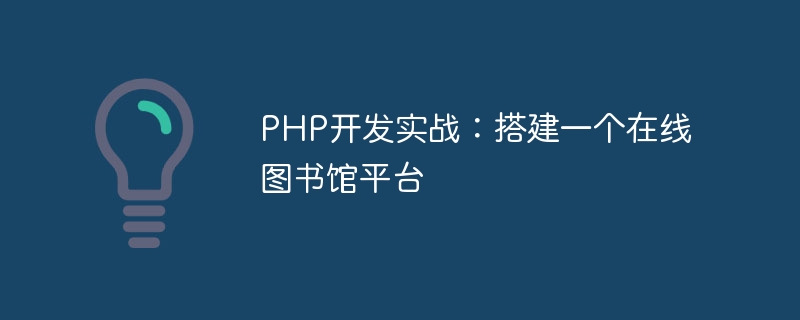
PHP development practice: building an online library platform
With the continuous development of technology, the traditional library service model is gradually being replaced by digitized and online books replaced by the pavilion platform. For those institutions or organizations that want to provide more convenient and efficient library services, building an online library platform is a very effective way. In this article, we will introduce how to develop a full-featured, user-friendly online library platform using PHP.
1. Requirements Analysis
Before building an online library platform, we must first clarify the functional requirements of the platform. A complete online library platform should have the following functions:
- User registration and login: Users can access the platform by registering an account, and the login function can ensure the security of user information and borrowing records.
- Book display and retrieval: The platform needs to provide a user-friendly interface, display the basic information of books, and provide a variety of retrieval methods, such as retrieval by book title, author, classification, etc.
- Borrowing and returning books: Users can borrow books independently through the platform and provide corresponding return functions.
- Borrowing records and book recommendations: The platform needs to record the user’s borrowing history and make book recommendations based on the user’s borrowing record.
- Administrator background management: The administrator needs to manage operations such as adding, deleting, and updating books, and also needs to manage users' borrowing records.
2. Technology Selection
The technologies required to build an online library platform generally include front-end technology and back-end technology. In this actual combat, we will use the following technologies to complete the construction of the platform:
- Front-end technologies: HTML, CSS, JavaScript, Bootstrap, etc.
- Back-end technology: PHP, MySQL.
3. System architecture design
Based on demand analysis and technology selection, we can design a simple system architecture. The entire system can be divided into three modules: front-end, back-end and database. The front-end is responsible for implementing the user interaction interface, and the back-end is responsible for processing user requests and interacting with the database. The database is used to store books and user information.
4. Functional implementation
- User registration and login
User registration requires a form for entering user name, password and other information, and verifying the legality of the input content. On the backend, you can use the form processing and encryption functions provided by PHP to complete the processing of registration requests. User login requires verification of the username and password entered by the user, and the user information is saved in the session after the verification is passed.
- Book display and retrieval
Book display requires designing a user-friendly interface and displaying the basic information of the book in a certain layout. You can use HTML and CSS to complete the layout and style design of the page. Book retrieval can use PHP to process the search conditions entered by the user, obtain the results through the MySQL database query, and display the results to the user in an appropriate manner.
- Borrowing and returning books
Users can click the borrow button on the book details page to send a borrowing request to the backend. On the backend, the user's borrowing permissions need to be checked and the borrowing records and book inventory information need to be updated. The implementation of returning books is similar to borrowing. Users need to enter the borrowing number of the book and send a return request to the backend. After processing by the backend, the borrowing record and book inventory information are updated.
- Borrowing records and book recommendations
Borrowing records can be displayed publicly in the user's personal center or homepage. By querying the borrowing records in the database, the user's borrowing history can be presented in the form of a list. Book recommendations can be implemented based on users' borrowing records. By analyzing the user's borrowing habits, relevant books can be recommended for the user, and the recommendation results will be displayed on the user's personal center or homepage.
- Administrator background management
The administrator background management function needs to be implemented in the background. Administrators can log in to the background to manage the addition, deletion and update operations of books, and can also view and manage users' borrowing records. These functions can be achieved by adding corresponding tables, forms, and buttons to the backend page, and using PHP to handle requests submitted by users.
5. Summary
Through the introduction of this article, we have learned how to use PHP to develop a fully functional, user-friendly online library platform. Building an online library platform can not only provide more convenient and efficient book services, but also recommend books through user borrowing records to improve user experience. Of course, in the actual development process, more detailed design and development work is required, but this framework can provide developers with a good starting point. I hope this article will be helpful to developers who want to build an online library platform.
The above is the detailed content of PHP development practice: building an online library platform. For more information, please follow other related articles on the PHP Chinese website!
Statement:The content of this article is voluntarily contributed by netizens, and the copyright belongs to the original author. This site does not assume corresponding legal responsibility. If you find any content suspected of plagiarism or infringement, please contact admin@php.cn
